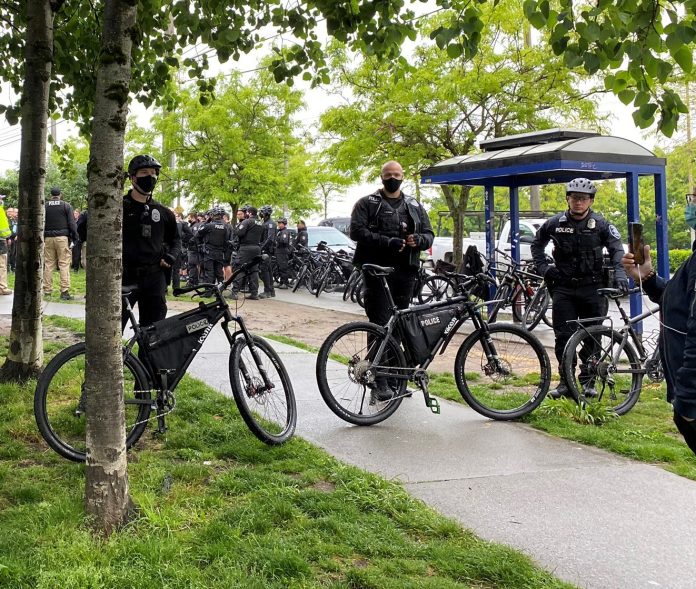
An excerpt from my new book, Heartbreak City, shows how Seattle kicked off a nationwide bike policing trend.
A distant frontier city that had only recently been deemed one of the great metropolises of the United States, Seattle pioneered an unprecedented experiment in public safety in 1987. In the go-go Reagan 80s, the city’s downtown was in a state of upheaval, undone utterly by construction cranes, craters of soil, and road closures. Global finance capital had rediscovered the city by the sea. Real estate then was a take-able piece of cheap carrion. But the new commercial attention presented a challenge to the city’s cops, charged as they were with negotiating the downtown labyrinth of new urban development.
“It was taking too long for officers in cars to get even a few blocks for a call,” recalled Assistant Seattle Police Chief Jim Deschane.
The city’s past suggested a way forward.
A little less than a century earlier, bikes had been a civilizing force in frontier Seattle, dragging the city from its wild past of sawdust roads and downtown saloons to the refined paved streets and civic gathering spaces of the Progressive Era.
With the advent of “safety bikes” that didn’t require riders to possess great strength and balance, the number of Seattle bikers exploded in the last decade of the nineteenth century: From one dozen riders in a city of 42,000 in 1892 to 10,000 riders in a city of 80,000 people in the year 1900. Concurrently, biking advocates advanced then-novel ideas for how to fund, manage, and deliver services in this rapidly growing city. The Queen City Good Roads Club suggested taxing Seattle bikers as a source of revenue. Others lobbied city officials for paths along Lake Washington that eventually became a stencil for Seattle’s first paved streets.
With the coming of the railroad in 1893, Seattle would be on its way to world class status, with the population growth and new skyscrapers like Smith Tower to prove it. Facing a similar phase of growth in the 1980s, Seattle turned once again to the spokes of change.
To police the new residents and commercial spaces that called Seattle home in the 1980s, Seattle cops turned to bikes. Seattle police would be more nimble, able to navigate the construction tunnels and excavations that carved up downtown. Cops would be more fleet, finding ways to bust shoplifters, nab drug dealers, and issue parking tickets.
The corporate titans and real estate tycoons remaking the city rallied in support of the new cop cyclists. A downtown North Face store provided spandex pants and jackets to the police. Property holders at a Pike Place Market-area condo wrote the city’s police department a handwritten letter of support.
The Seattle Police Department would be the first in the country to put cops on two-wheels. They would risk ridicule, then become a model for cops across the country. “In 1987, everybody laughed,” said Sgt. Paul Grady, one of the city’s original bike-patrol officers, and author of Policing by Mountain Bike. “In 1988, they raised their eyebrows and noticed we were still doing it. In 1989, other departments started contacting us, and in 1990 it just took off by the hundreds of other departments.”
Seattle had scored again. Its growing reputation as a forward-thinking city of the future was further boosted by its experimental, Reagan-era repression of the urban poor.
###
Since the 19th century days of westward expansion, the promise of western cities like Seattle had always entailed separation from the social problems — real and perceived — of older East Coast cities. “Americans believed about the west not so much what was true, but what they thought ought to be true,” paraphrased President Reagan in 1983.
Back in 1972, New York publisher Doubleday Books dubbed Seattle “one of America’s most exciting cities.” In 1975, Harper’s Magazine ranked it the “least-worst city” in the country. By 1982, Sports Illustrated gushed over the Emerald City (the nickname given the city by the Seattle-King County tourist board a year earlier), writing “through two decades of significant change against a backdrop of deterioration of American cities generally, Seattle has emerged as a testimony of what urban living could be if cities were moderately populated, surrounded by water, and watched over by a citizenry that knows how lucky it is.”
Ever since it chased railroads and served as a jumping-off point for the Alaska Gold Rush in the bike-boom days of the 1890s, Seattle had been a booster city. In the 1980s, it entered an era that was as materialistic as any other.
Seattle grew glitzier.
In his book Seattle and the Demons of Ambition, reporter Fred Moody describes how one million square feet of new office space came online downtown in 1984, much of it in the seventy-six-story Columbia Tower that opened that year. Activist Jim Ellis championed a glossy convention center that opened in 1982, and the shiny mall, Westlake Center, opened in 1988. In August 1987, an extensive excavation on Third Avenue for a new transit tunnel compelled city officials to put cops on bikes. Seattle seemed America’s new model city, with spanking new public and private spaces, and politicians willing to go to great lengths to police them.
After a generation of divestment from city centers in favor of suburbs, downtowns had become fashionable again. And the fashion was for blandly appealing spaces for people to blow money in and leave. Just as growing wealth disparities in 1980s Los Angeles led to the creation of a vast security apparatus of surveillance cameras, prisons, and policing — detailed in Mike Davis’ City of Quartz — so too was Reagan Era Seattle the site of a new carceral urbanism.
Bike cops were but one piece of Seattle’s security state puzzle. Despite years of demonstrations from Capitol Hill residents who objected to it, the Seattle Police Department opened its East Precinct near Cal Anderson Park in 1986. Later that year, King County officials opened a downtown jail that put a $179 million hole in the county budget, forcing the County to take funds from the tourism board to cover cost overruns.
New transit tunnels were taking people to and from great new commercial spaces; bike cops were policing downtown malls, placing street dealers and petty criminals in costly new prisons. For many years in the United States, this is what urbanism meant, explaining, to some extent, a still-extant divide between many urbanists and critics of American police power.
Was Seattle a different kind of city if it hosted the same old political divides?
Editor’s note: This article was adapted from a chapter of Heartbreak City: Seattle Sports and the Unmet Promise of Urban Progress — Shaun Scott’s new book just released from University of Washington Press, and reprinted with the publisher’s permission.
As the publisher notes, “In Heartbreak City Shaun Scott takes the reader through 170 years of Seattle history, chronicling both well-known and long-forgotten events, like the establishment of racially segregated golf courses and neighborhoods in the regressive 1920s and the 1987 Seahawks players’ strike that galvanized organized labor. At every step of the journey, he uncovers how sports have both united Seattle in pursuit of triumph and revealed its most profound political divides. Deep archival research and analysis combine in this people’s history of a great American city’s quest to become even greater — if only it could get out of its own way.”
Hear more from Scott at the Futurewise End of Year Party on Thursday December 7th. Scott will speak with Futurewise about what we can learn from Seattle’s past as we gear up for the 2024 comprehensive plan update. RSVP at www.futurewise.org/eoy2023.

Shaun Scott
Shaun Scott is a Seattle writer. His book Heartbreak City is available wherever books are sold.
